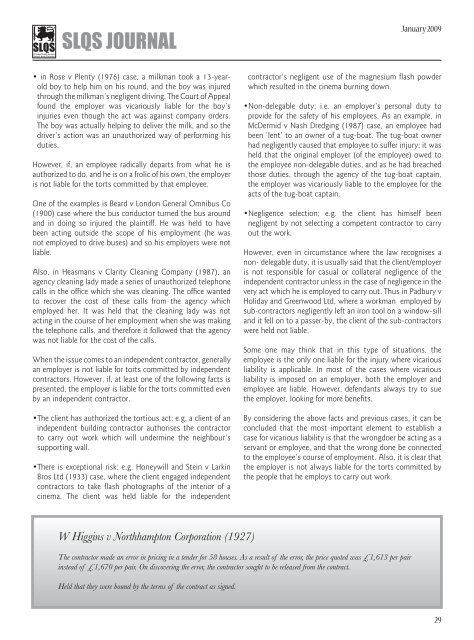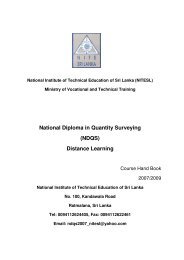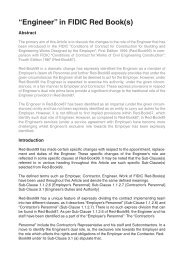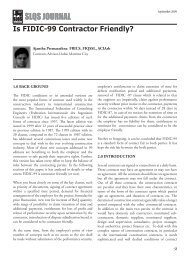SLQS-Journal Vol. 1 - Slqs-uae.org
SLQS-Journal Vol. 1 - Slqs-uae.org
SLQS-Journal Vol. 1 - Slqs-uae.org
You also want an ePaper? Increase the reach of your titles
YUMPU automatically turns print PDFs into web optimized ePapers that Google loves.
<strong>SLQS</strong> JOURNALJanuary 2009• in Rose v Plenty (1976) case, a milkman took a 13-yearoldboy to help him on his round, and the boy was injuredthrough the milkman’s negligent driving. The Court of Appealfound the employer was vicariously liable for the boy’sinjuries even though the act was against company orders.The boy was actually helping to deliver the milk, and so thedriver’s action was an unauthorized way of performing hisduties.However, if, an employee radically departs from what he isauthorized to do, and he is on a frolic of his own, the employeris not liable for the torts committed by that employee.One of the examples is Beard v London General Omnibus Co(1900) case where the bus conductor turned the bus aroundand in doing so injured the plaintiff. He was held to havebeen acting outside the scope of his employment (he wasnot employed to drive buses) and so his employers were notliable.Also, in Heasmans v Clarity Cleaning Company (1987), anagency cleaning lady made a series of unauthorized telephonecalls in the office which she was cleaning. The office wantedto recover the cost of these calls from the agency whichemployed her. It was held that the cleaning lady was notacting in the course of her employment when she was makingthe telephone calls, and therefore it followed that the agencywas not liable for the cost of the calls.When the issue comes to an independent contractor, generallyan employer is not liable for torts committed by independentcontractors. However, if, at least one of the following facts ispresented, the employer is liable for the torts committed evenby an independent contractor.•The client has authorized the tortious act; e.g. a client of anindependent building contractor authorises the contractorto carry out work which will undermine the neighbour’ssupporting wall.•There is exceptional risk; e.g. Honeywill and Stein v LarkinBros Ltd (1933) case, where the client engaged independentcontractors to take flash photographs of the interior of acinema. The client was held liable for the independentcontractor’s negligent use of the magnesium flash powderwhich resulted in the cinema burning down.•Non-delegable duty; i.e. an employer’s personal duty toprovide for the safety of his employees. As an example, inMcDermid v Nash Dredging (1987) case, an employee hadbeen ‘lent’ to an owner of a tug-boat. The tug-boat ownerhad negligently caused that employee to suffer injury; it washeld that the original employer (of the employee) owed tothe employee non-delegable duties, and as he had breachedthose duties, through the agency of the tug-boat captain,the employer was vicariously liable to the employee for theacts of the tug-boat captain.•Negligence selection; e.g. the client has himself beennegligent by not selecting a competent contractor to carryout the work.However, even in circumstance where the law recognises anon- delegable duty, it is usually said that the client/employeris not responsible for casual or collateral negligence of theindependent contractor unless in the case of negligence in thevery act which he is employed to carry out. Thus in Padbury vHoliday and Greenwood Ltd, where a workman employed bysub-contractors negligently left an iron tool on a window-silland it fell on to a passer-by, the client of the sub-contractorswere held not liable.Some one may think that in this type of situations, theemployee is the only one liable for the injury where vicariousliability is applicable. In most of the cases where vicariousliability is imposed on an employer, both the employer andemployee are liable. However, defendants always try to suethe employer, looking for more benefits.By considering the above facts and previous cases, it can beconcluded that the most important element to establish acase for vicarious liability is that the wrongdoer be acting as aservant or employee, and that the wrong done be connectedto the employee’s course of employment. Also, it is clear thatthe employer is not always liable for the torts committed bythe people that he employs to carry out work.W Higgins v Northhampton Corporation (1927)The contractor made an error in pricing in a tender for 58 houses. As a result of the error, the price quoted was £1,613 per pairinstead of £1,670 per pair. On discovering the error, the contractor sought to be released from the contract.Held that they were bound by the terms of the contract as signed.29





